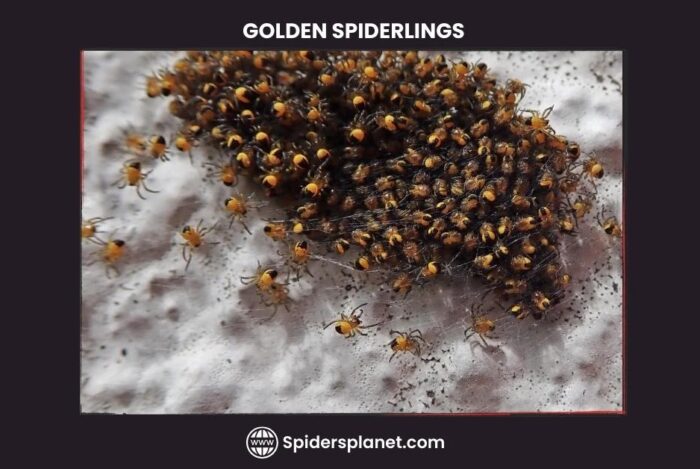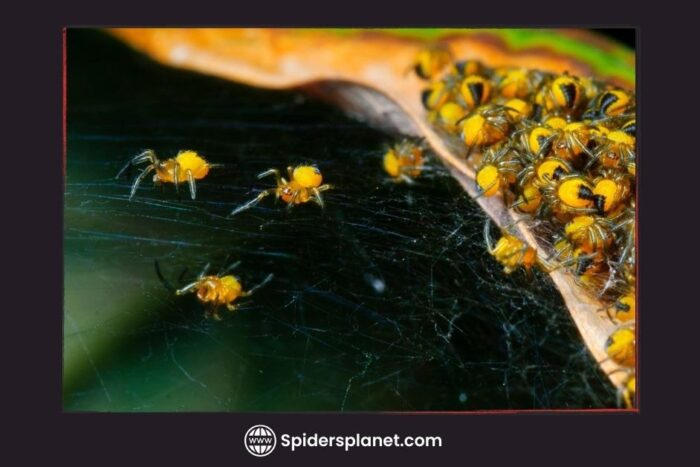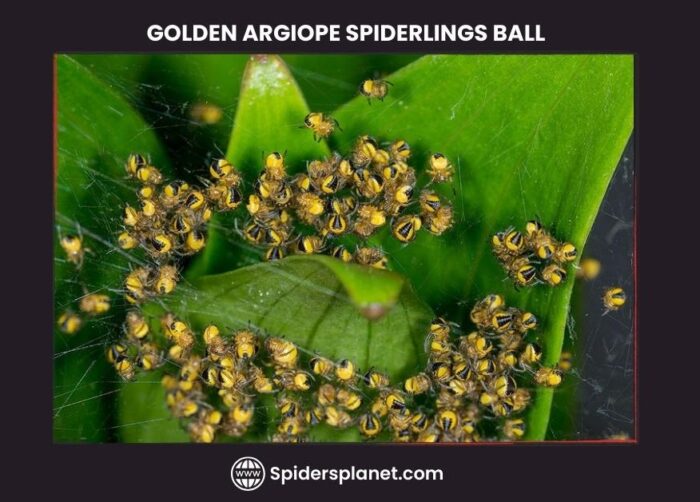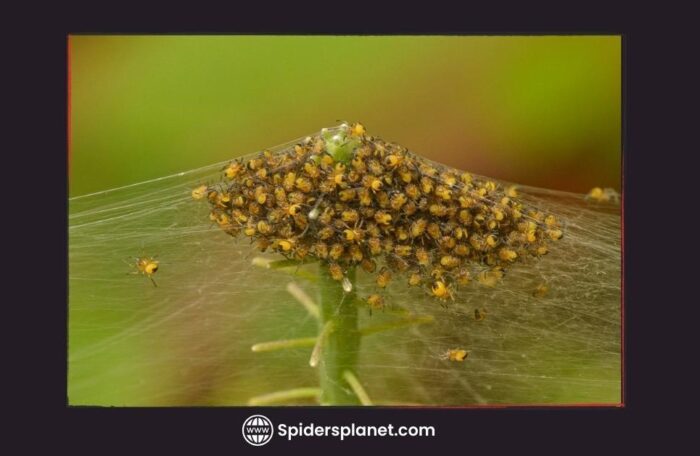Baby jumping spiders are commonly known as spiderlings. These adorable offspring belong to one of the most agile and intelligent spider species (Salticidae). Born just a few millimeters long, these tiny marvels invite you into the world of spiderling parenting.
Are you curious to learn more about these adorable jumping spider babies? To discover their life stages, witness their growth, understand their feeding habits, know the world of motherly care, and explore their enclosures. Keep scrolling!
What do we call a Baby Spider?
The offspring of spiders or Juvenile jumping spiders are called “Spiderlings” or “ Slings.” They are miniature arachnids that emerge from eggs laid by female spiders. Despite being born with all eight legs, these tiny creatures are initially extremely small and delicate, often so young that they remain either on the back of their mother or sheltered within the protective embrace of an egg sac for a period after their hatching.
These tiny wonders represent the earliest chapters in the fascinating life cycle of spiders, showcasing nature’s intricate design and the tender care provided by arachnid mothers.

Baby Jumping Spiders and their Development:
Laying Eggs:
When a female spider is pregnant, she usually lays eggs within one day to two weeks after mating, but she can wait up to a year before doing so. The eggs are placed in a dense, fluffy sac, typically located at the top of her enclosure.
If you suspect your spider has mated, it’s important to know that the baby spiders (spiderlings) are very small and can easily escape if the enclosure is not secure. After laying eggs, the mother protects them, often refraining from eating or drinking. While you can offer occasional food or water, it is fine if she does not consume it.
How many Baby Jumping Spiders are in Egg Sacks?
The quantity of baby jumping spiders within an egg sac varies among species, usually ranging from 20 to 100 eggs per sac. For instance, the common jumping spider, Phidippus audax, typically lays between 30 and 80 eggs per sac.
In contrast, the Hyllus giganteus, one of the largest jumping spider species, can lay an impressive 300 eggs per sac. This diversity in brood sizes highlights the species-specific reproductive strategies among these agile arachnids.
Hatching from Eggs:
Spiders commonly lay their eggs in silk sacs. The quantity of eggs and the appearance of these sacs differ among species. When the eggs are prepared to hatch, spiderlings emerge from the sac.
Size and Appearance:
Baby jumping spiders are incredibly small, initially measuring just 1/16 of an inch in length. When they hatch, they are transparent with a pale yellowish-white color. As they mature, they acquire distinctive black and white markings. Despite their size, these tiny creatures are remarkably active and agile.

Spiderlings, much like their adult counterparts, possess eight legs, a distinguishing feature of arachnids. Their bodies are divided into two primary parts: the cephalothorax, which is a fusion of the head and thorax, and the abdomen.
Baby Jumping Spiders’ Eight-Eyed Wonders:
Despite their small size, cute baby jumping spiders possess impressive vision with eight eyes that allow for a high-detail, colorful sight. The two large front eyes, or principal eyes, function like miniature telescopes, enabling detailed vision from a distance.
These eyes move independently, aiding depth perception crucial for accurate jumping. Additionally, six smaller secondary eyes broaden their field of view, assisting in detecting movement and objects outside direct frontal vision.
This exceptional vision equips them for tasks such as hunting, navigating, and avoiding predators. Their ability to jump significant distances, up to 25 times their body length, showcases the practical applications of their extraordinary eyesight, contributing to their thriving in their environment.
Baby Jumping Spiders Food:
In parallel to nursing baby mammals, certain jumping spiders begin their lives by consuming nutritious “spider milk” secreted by their mothers. Remarkably, the spider mothers persist in caring for and nourishing their young with this milk-like fluid, even after the spiderlings become capable of foraging for food independently.
A recent study reveals that this spider milk boasts nearly four times the protein found in cow’s milk, emphasizing the distinctive and attentive maternal care exhibited by these arachnids.

Further, you can deal with spiderlings (slings) with fruit flies, springtails, and pinhead crickets that are about the size of fruit flies. As they grow, they can transition to extra-small crickets, mini mealworms, and fly larvae for sustenance. Adjusting the size of their prey to accommodate their growth is crucial for the well-being of these petite jumping spiders.
Spiderlings’ Early Challenges:
Spiderlings, after hatching, may use a technique called ballooning, releasing silk threads into the air to be carried by the wind. This helps them discover new areas and avoid competition with their siblings. However, during this stage, they face vulnerability, being at risk of predators, and their survival can be affected by environmental conditions.
Baby Spider Growth: The Importance of Molting
Spiderlings undergo a vital process known as molting, which is essential for their growth and development. Molting involves shedding its rigid outer covering, called the exoskeleton, and emerging with a larger, more flexible one underneath.
Jumping spiders grow up by going through several molts, like shedding old clothes. The number of molts varies by species but is usually around 5 to 10 times. When they’re all grown up, they can mate and have babies.
Jumping Spider Adulthood:
Following numerous molts, jumping spiders enter adulthood. Adult jumping spider are generally larger and boast more vibrant colors compared to their younger counterparts. They exhibit increased agility and the ability to leap significant distances.
Male jumping spiders leverage their jumping prowess to impress females during courtship. Female spiders play a really important job, i.e., they lay eggs and take care of their offspring.
Caring for Spider Eggs and Spiderlings:
Typically, the mother spider diligently guards the eggs for 2-6 weeks until they hatch and then continues to protect the spiderlings until they are ready to venture out on their own. It is important not to disturb them during this period.
While it is okay to offer the mother food (though she might not accept it), maintaining a humid environment is crucial. When providing water, exercise caution to prevent spiderlings from drowning; a fine mist from a spray bottle can be gently released into the enclosure to fulfill their hydration needs.
Baby Jumping Spider Enclosure Essentials:
Creating an optimal home for baby-jumping spiders involves key considerations.
- Begin with a small, well-ventilated enclosure, such as a deli cup for tiny spiderlings, progressing to a 10-gallon aquarium as they mature.
- Ensure adequate ventilation through small holes or gaps to prevent respiratory issues.
- Mimic their natural habitat with suitable substrates like coconut coir and provide climbing structures such as twigs or cork bark.
- Maintain a slightly humid environment through misting or a small water dish, with a temperature range of 70-80°F (21-27°C).
- Feed them small prey like fruit flies or crickets 2-3 times a week and practice regular spot cleaning to prevent mold.
- Deep cleaning and replacing substrate and décor are advisable every few months. For species-specific care, consult experienced keepers or reliable sources.
Unfertilized and Unwanted Spider Eggs:
If your spider lays infertile eggs, it is best not to disturb the sac as she will sit on it without eating for 1-2 weeks. If you have unwanted spider eggs, releasing local spiderlings is an option, or find someone to take exotic ones. If necessary, destroy the sac at night to minimize stress, but it may lead to the spider not eating or drinking for a few weeks.

How many Baby Spiders survive?
The survival prospects of baby jumping spiders, while species-dependent, generally lag behind those of their adult counterparts, with an estimated 10-20% reaching maturity. Various factors contribute to this lower survival rate.
- Predation poses a significant threat, with baby jumping spiders falling prey to a range of animals, including other spiders, birds, and lizards.
- Starvation is another challenge, as these tiny spiders require frequent meals for growth, and inadequate food availability may lead to starvation. Diseases, such as fungal and bacterial infections, also pose risks to their survival, along with parasitism by other insects, which can weaken and ultimately kill them.
- Moreover, habitat loss, such as the depletion of natural environments like forests and grasslands, further diminishes the survival chances of jumping spider baby.
FAQs:
Do baby spiders eat their mom?
In certain spiders, like some jumping spiders, baby spiders practice matriphagy, eating their mother. This behavior is common when the mother provides nutrients like hemolymph, a blood-like fluid. The mother either allows suckling or regurgitates hemolymph for them.
Are baby-jumping spiders poisonous?
Jumping spider baby, despite having fangs and venom, pose no threat to humans. They are among the least venomous spiders globally, using their venom solely to subdue small insects. Even if bitten, the experience is typically mild, comparable to a mosquito bite. Allergic reactions are rare and more likely in individuals already sensitive to spider venom. Overall, interactions with these tiny spiders are harmless.
Final Thoughts:
Baby jumping spiders are awesome, as they make cool silk structures, are great hunters, and some even take care of their moms. Studying them helps us learn about nature and how things evolve. It is important to keep their homes safe and understand their role in keeping our world balanced. Taking care of them is like taking care of our planet’s special treasures.




Leave a Reply